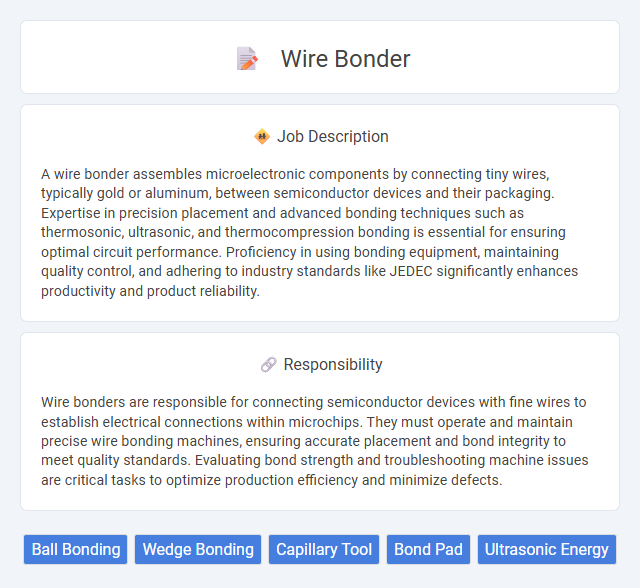
A wire bonder assembles microelectronic components by connecting tiny wires, typically gold or aluminum, between semiconductor devices and their packaging. Expertise in precision placement and advanced bonding techniques such as thermosonic, ultrasonic, and thermocompression bonding is essential for ensuring optimal circuit performance. Proficiency in using bonding equipment, maintaining quality control, and adhering to industry standards like JEDEC significantly enhances productivity and product reliability.
Individuals with steady hands, good eyesight, and strong attention to detail are likely suitable for wire bonder roles due to the precision required in connecting tiny components. People who experience significant hand tremors, vision impairments, or difficulty with fine motor skills may find this job challenging. The job's repetitive nature might not suit those who prefer varied tasks or have difficulty maintaining focus for extended periods.
Qualification
A wire bonder technician requires a strong background in electronics or electrical engineering, typically supported by an associate degree or vocational training in microelectronics or semiconductor technology. Proficiency in operating advanced wire bonding equipment, understanding of semiconductor materials, and precision in handling microscopic components are crucial qualifications. Experience with quality control standards and the ability to troubleshoot bonding defects enhance job performance in this specialized manufacturing role.
Responsibility
Wire bonders are responsible for connecting semiconductor devices with fine wires to establish electrical connections within microchips. They must operate and maintain precise wire bonding machines, ensuring accurate placement and bond integrity to meet quality standards. Evaluating bond strength and troubleshooting machine issues are critical tasks to optimize production efficiency and minimize defects.
Benefit
Wire bonder jobs likely provide significant benefits such as competitive salaries and comprehensive health insurance, enhancing overall employee well-being. Employees in this role might also gain access to advanced training programs, increasing their technical skills and career advancement prospects. The job may offer a stable work environment with potential opportunities for overtime pay, contributing to financial security.
Challenge
Wire bonder jobs likely involve complex precision tasks that require steady hands and acute attention to detail. Workers probably face challenges related to maintaining quality and consistency under time constraints in high-tech manufacturing environments. Adapting to evolving technology and troubleshooting bonding issues may also be common difficulties in this role.
Career Advancement
Wire bonder technicians can advance their careers by developing expertise in advanced bonding techniques used in semiconductor packaging and microelectronics manufacturing. Mastery of automated wire bonding equipment and process optimization increases opportunities for supervisory or engineering roles. Gaining certifications in quality control and failure analysis enhances potential for leadership positions in production and R&D departments.
Key Terms
Ball Bonding
Ball bonding in wire bonder jobs involves creating precise connections between semiconductor devices and their packaging using fine wire, typically gold or copper. This technique requires expertise in controlling ultrasonic, thermal, and mechanical parameters to ensure strong, reliable bonds that maintain electrical performance. Mastery of ball bonding enhances production yield and device reliability in microelectronics manufacturing.
Wedge Bonding
Wedge bonding is a critical process in semiconductor packaging, involving the use of a fine wire and ultrasonic energy to create reliable electrical connections between a chip and its substrate. Operators must precisely control parameters such as bond force, ultrasonic power, and time to ensure strong, defect-free bonds. Mastery in wedge bonding enhances device performance and yield, making skilled wire bonder technicians essential in microelectronics manufacturing.
Capillary Tool
The wire bonder job primarily involves precision handling of the capillary tool to create reliable wire bonds between semiconductor components and substrates. The capillary tool's design and material composition are critical for achieving optimal bond strength and minimizing damage during ultrasonic or thermosonic bonding processes. Mastery of capillary tool alignment, pressure, and bonding parameters ensures high yield and consistent electrical connectivity in microelectronic packaging.
Bond Pad
A wire bonder precisely connects the bond pads on semiconductor devices to external circuitry, ensuring reliable electrical conductivity and signal transmission. The bond pad's material composition, surface morphology, and cleanliness are critical factors influencing bond strength and long-term device performance. Advanced wire bonding techniques optimize contact integrity on bond pads, minimizing resistance and preventing wire lift-off during mechanical and thermal stress.
Ultrasonic Energy
Wire bonder technology relies heavily on ultrasonic energy to create reliable electrical connections between semiconductor devices and substrates. The ultrasonic vibrations generate frictional heat, enabling precise bonding without damaging delicate components. Optimizing ultrasonic energy parameters ensures enhanced bond strength, reduced cycle time, and improved overall device performance.
 kuljobs.com
kuljobs.com